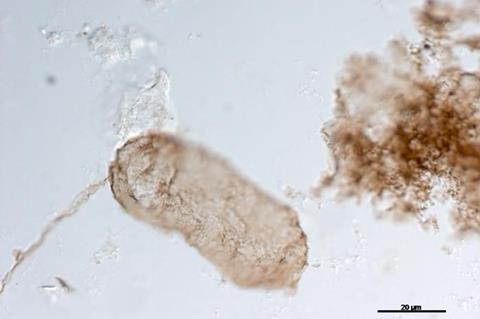Researchers at the University of Liège (ULiège) have identified microstructures in fossil cells that are 1.75 billion years old. These structures, called thylakoid membranes, are the oldest ever discovered.
They push back the fossil record of thylakoids by 1.2 billion years and provide new information on the evolution of cyanobacteria which played a crucial role in the accumulation of oxygen on the early Earth. This major discovery is presented in the journal Nature.
Catherine Demoulin, Yannick Lara, Alexandre Lambion and Emmanuelle Javaux from the Early Life Traces & Evolution laboratory of the Astrobiology Research Unit at ULiège examined enigmatic microfossils called Navifusa majensis (N.majensis) in shales from the McDermott Formation in Australia, which are 1.75 billion years old, and in 1 billion year old formations of DRCongo and arctic Canada.
Ultrastructural analyses in fossil cells from 2 formations (Australia, Canada) revealed the presence of internal membranes with an arrangement, fine structure and dimensions permitting to interpret them unambiguously as thylakoid membranes, where oxygenic photosynthesis occurs. These observations permitted to identify N majensis as a fossil cyanobacterium.

Role of cyanobacteria
This discovery puts into perspective the role of cyanobacteria with thylakoid membranes in early Earth oxygenation. They played an important role in the early evolution of life and were active during the Great Oxygenation Event (GOE), around 2.4 billion years ago.
However, the chronology of the origins of oxygenic photosynthesis and the type of cyanobacteria (protocyanobacteria? With or without thylakoids?) involved remain debated, and the ULiège researchers’ discovery offers a new approach to clarify these issues.
“The oldest known fossil thylakoids date back to around 550 million years. The ones we have identified therefore extend the fossil record by 1.2 billion years”, explains Professor Emmanuelle Javaux, paleobiologist and astrobiologist, director of the Early Life Traces & Evolution laboratory at ULiège.
“The discovery of preserved thylakoids in N. majensis provides direct evidence of a minimum age of around 1.75 billion years for the divergence between cyanobacteria with thylakoids and those without.”
Ancient fossils
But the ULiège team’s discovery raises the possibility to discover thylakoids in even older cyanobacterial fossils, and to test the hypothesis that the emergence of thylakoids may have played a major role in the great oxygenation of the early Earth around 2.4 billion years ago. This approach also permits to examine the role of dioxygen in the evolution of complex life (eucaryote) on our planet, including the origin and early diversification of algae that host chloroplasts derived from cyanobacteria.
“Microscopic life is beautiful, the most diverse and abundant form of life on Earth since the origin of life. Studying its fossil record using new approaches will enable us to understand how life evolved over at least 3.5 billion years. Some of this research also tells us how to search for traces of life beyond Earth,” concludes Emmanuelle Javaux.







No comments yet